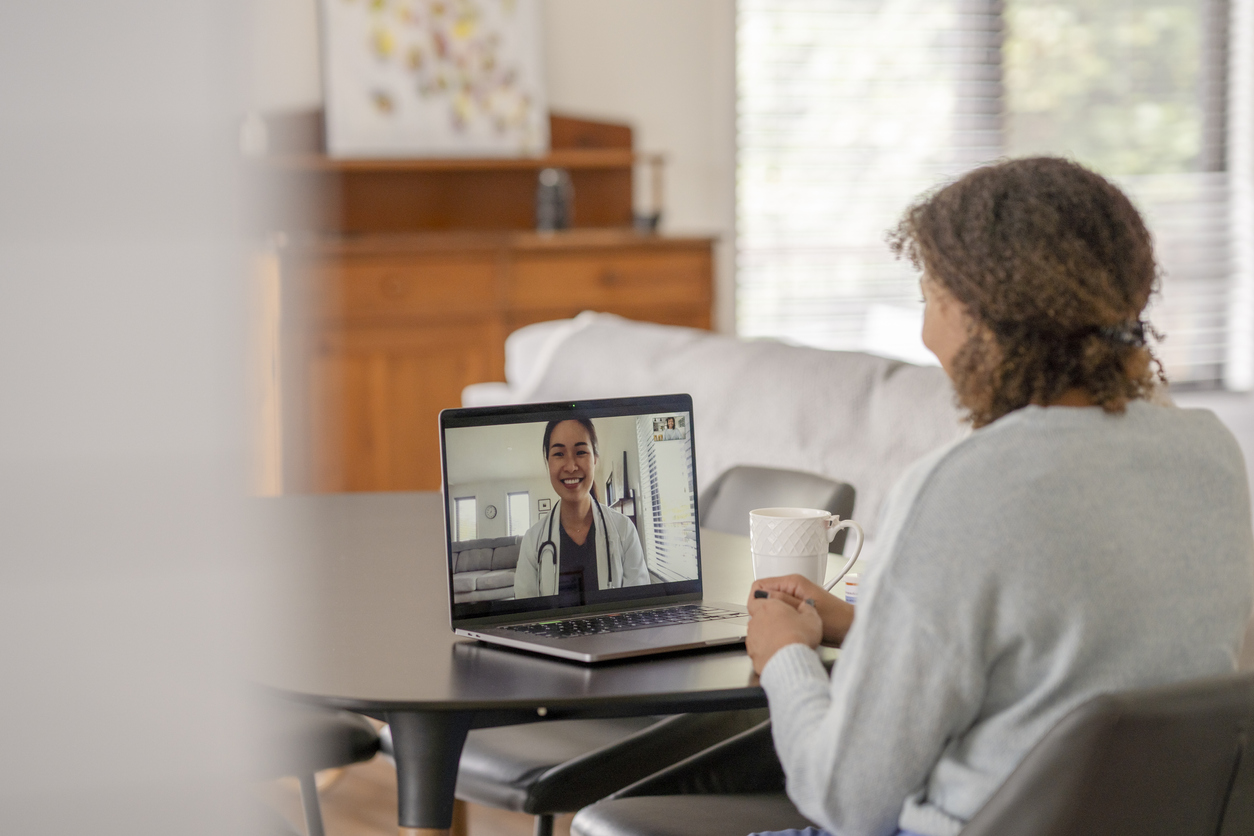Your Guide to Telehealth in Oklahoma
Written by: University of Tulsa • Mar 4, 2024

Your Guide to Telehealth in Oklahoma ¶
Telehealth is one of the biggest technological leaps in the health care industry in recent history, enabling patients to consult with physicians and other health care professionals from the comfort of their own homes using remote internet access. Although the concept of telehealth has existed for several decades, its rise to national prominence came about due to social distancing restrictions during the COVID-19 pandemic, changes to health care policy, and increased access to technology.
In 2010, the Pew Research Center reported that only 66% of U.S. adults had access to high-speed internet. However, the technological landscape is much different today. According to the Federal Communications Commission (FCC), 99.2% of Americans had access to at least one high-speed broadband internet provider in 2021, and 97% of Americans had access to at least three providers, marking a significant increase from a decade ago.
Now, most Americans not only have access to high-speed internet access but also have at least one device that makes accessing telehealth services possible. According to data from Consumer Affairs, 92% of Americans have at least one smartphone. Widespread access to technology combined with software platforms that support virtual visits make getting telehealth in Oklahoma possible for patients in each of its 77 counties, including services for Native American communities.
Oklahoma residents should familiarize themselves with how to navigate telehealth services within their state, including the services that they have access to and the technological requirements that they must meet to initiate telehealth appointments. Furthermore, they should explore the regulatory framework that governs telehealth services within their state concerning patient privacy and insurance coverage.
Understanding telehealth in Oklahoma, including how to access it and the most pertinent rules and regulations, will help residents get the most from their health care plans.
A Brief History of Telehealth Services ¶
The concept of telehealth dates back to the 1940s, when radiology images were sent between two Pennsylvania townships using a telephone line. This event is noteworthy because it’s the first electronic medical record transfer in history.
Clinicians at the University of Nebraska were the first to use video communications for medical purposes in 1959. Using a two-way TV setup, clinicians transmitted information to medical students across the college’s campus. The technology was broadly adopted by colleges and other medical facilities as it became more accessible and refined.
In the 1960s, research into telehealth and telehealth technologies received major investments from organizations such as the U.S. Health and Human Services Department (HHS), the U.S. Department of Defense (DOD), NASA, and the Public Health Department. One of the most noteworthy projects was Space Technology Applied to Rural Papago Advanced Health Care (STARPAHC), which enabled astronauts in orbit and Native Americans on the Papago Reservation to get remote access to medical care.
As technology evolved and medical providers saw the potential of telehealth, additional funding was invested in research and more ambitious projects. With the advent of the Internet of Things (IoT) and the burgeoning COVID-19 pandemic, transitioning from traditional face-to-face appointments to telehealth wasn’t just convenient — it was essential to mitigate the spread of the virus.
What’s Telehealth? ¶
Telehealth (also called e-health or mobile health) is broadly defined as the use of communication technologies and digital information to access health care services remotely. Applicable technologies include smartphones, desktop computers, laptop computers, and tablet computers. Patients may access health care providers using the technology that they already own or through local health care access points that provide patient access, such as medical offices and mobile medical vans.
A telehealth visit, or virtual visit, consists of a meeting with a physician or another health care provider using videoconferencing software and hardware or an audio-only call. Although neither party is physically present, physicians can still accomplish many of the same things that they would during an in-person meeting, including administering a diagnosis, prescribing medications, and developing personalized care plans.
When discussing the concept of telehealth versus telemedicine, some may use these terms interchangeably. According to the American Academy of Family Physicians (AAFP), the term “telemedicine” refers to the practice of using technologies that enable patients and their health care providers to meet remotely. By comparison, the term “telehealth” is broader in scope and includes other nonclinical services, such as public health education, provider training, and continuing medical education.
Goals of Telehealth ¶
When comparing telehealth to traditional in-person visits, naturally, there are certain challenges that telehealth is designed to address that in-person visits can’t. The following are some of the main goals of telehealth medicine:
-
To make accessing health care services easier for those with travel restrictions, physical limitations, or busy schedules, or who live or work in remote areas
-
To keep health care providers and others safe from communicable diseases, such as COVID-19
-
To offer another avenue of access to primary care that helps diagnose and treat a broad range of conditions
-
To offer health care access to a broad network of physicians and specialists that may not otherwise be possible for logistical reasons
-
To improve the coordination of care and communication between health care providers and their patients
-
To offer a readily available resource for the self-management of health care conditions
-
To improve how health care conditions are monitored using IoT and wearable devices that track, store, and transmit medical data
-
To decrease health care costs by reducing the need for physical space, staff, and other items commonly associated with health care overhead
-
To expand health care access using telehealth services that are available 24/7/365
Technological Requirements of Telehealth ¶
Using telehealth in Oklahoma means meeting certain technological requirements to access and maintain a stable connection with a health care provider. The requirements include the following:
-
High-speed internet access with a minimum of 10 megabits per second (Mbps) download speed and 5 Mbps upload speed.
-
Reliable hardware that supports virtual visits, such as a late-model smartphone or a computer with high-resolution video and audio capabilities.
-
Telehealth or videoconferencing software that’s secure, provides a reliable connection between patients and their health care providers, and is compliant with the Health Insurance Portability and Accountability Act (HIPAA). Video platforms such as Zoom and FaceTime don’t comply with HIPAA regulations and lack certain encryption security features.
Limitations of Telehealth ¶
Although telehealth has accomplished a lot in expanding health care access and making it more convenient for patients, it’s not without its limits and potential risks. The most noteworthy include the following:
-
Potential gaps in care due to lack of in-person access to patients
-
Overuse or unnecessary use of telehealth services by patients
-
Physical exams that aren’t comprehensive, potentially resulting in inaccurate diagnoses
-
Some states’ insurance reimbursement restrictions surrounding telehealth
-
Patients not meeting the technological requirements for telehealth services
-
Failure of technology or telehealth software platforms to work as intended
-
Patients’ feeling disconnected from their health care providers, resulting in dissatisfaction with virtual visits.
-
Potential for inaccurate dosing when prescribing drugs based on a patient’s weight
-
Medical conditions that aren’t appropriate for a telehealth environment because they require diagnostic tests or an in-person examination
Services Provided by Telehealth ¶
Telehealth enables patients to remotely access various health care services. Telehealth.HHS.gov lists the following services that patients can access via a telehealth environment:
-
Explanation and review of X-rays and other lab test results
-
Counseling, medication management, online therapy, and other mental health treatments
-
Treatments for recurring conditions, such as chronic migraines and psoriasis
-
Treatment for acute conditions or urgent care issues, such as stomach aches and colds
-
Postsurgical follow-up appointments
-
Appointments for attention deficit hyperactivity disorder (ADHD), chronic anxiety, depression, and sleep disorders
-
Occupational therapy
-
Physical therapy
-
Remote health monitoring for conditions such as high blood pressure and diabetes
-
Minor injuries and illnesses, such as allergies, rashes, ear infections, fever, flu, sinus infections, urinary tract infections, pink eye, and insect stings and bites
Main Benefits of Telehealth ¶
Through the use of telehealth, patients and their health care providers benefit in numerous ways, including the following:
-
Health care providers greatly reduce their risk of contracting communicable diseases.
-
Virtual visits overcome logistical limitations relating to travel, physical location, and personal ability.
-
Telehealth provides convenience to those with busy schedules who can’t take time off work or can’t secure child care.
-
Telehealth cuts down on travel time and often results in shorter wait times for patients.
-
Patients have increased access to specialists.
-
Telehealth is easy to use and secure.
Residents of Oklahoma know that the state includes many rural, sparsely populated areas. With access to telehealth, Oklahoma residents no longer need to travel long distances to see physicians who specialize in cardiology or oncology. Granted, physicians can’t perform certain exams using telehealth, but they can use it to conduct most follow-up and health monitoring appointments.
How to Initiate a Telehealth Appointment ¶
Ideally, patients should figure out who’ll be their telehealth provider in advance, as it’ll save them valuable time later should they become ill or sustain an injury. According to the Health Resources and Services Administration (HRSA), patients can locate and book a telehealth provider in the following four ways:
-
Ask their physician if they provide telehealth services.
-
If their physician doesn’t provide telehealth, ask them to recommend a physician who does.
-
Check with their health care insurance providers to find in-network telehealth providers for family care and specialty care. This can be done either through the insurance provider’s portal or by contacting their customer service line.
-
Speak with their local health care centers or urgent care about available telehealth resources. Those who wish to perform an online search can do so at Findahealthcenter.HRSA.gov.
After identifying a telehealth provider, patients can make appointments just as they would with any other health care provider. They’ll be provided a date and time for the virtual appointment along with a URL or patient portal access instructions.
Preparing for Telehealth Appointment ¶
After a patient has scheduled a telehealth appointment, they should complete the following steps to ensure that the virtual visit goes smoothly with no unforeseen technological challenges:
-
Make sure that the technology functions as it should. This means checking the internet connection and confirming that the video and audio software are in working order.
-
Notify the health care provider about any special accommodations, such as closed captioning, a translator, or other support services.
-
Establish a quiet, well-lit spot to conduct the telehealth appointment. When the appointment is to begin, patients should close any applications that they’re not using to free up their hardware’s memory.
-
Read the telehealth email confirmation and appointment instructions carefully. They’ll include specific steps and links to access the appointment. Patients are recommended to show up a few minutes early to their appointments and wait in the virtual meeting room until it’s time to start.
-
Treat the telehealth appointment the same as an in-person appointment. Patients should give the physician their undivided attention and note anything that they may want to refer to later.
-
After the appointment, most telehealth providers send a virtual meeting recap that patients should keep for their records.
Telehealth Troubleshooting ¶
Some patients may experience issues when attempting to access their telehealth appointments. The following are some common troubleshooting tactics to use:
-
Confirm that the device is sufficiently charged.
-
Confirm that the internet connection is stable.
-
Restart the computer, smartphone, or tablet.
-
Close any unused applications.
-
Update the device to the most recent version of the operating system (OS).
-
Update the browser software to the most recent version.
-
If one device isn’t working, try another.
-
If all else fails, call the provider directly, as some appointments can be conducted by phone.
Legal Requirements for Telehealth in Oklahoma ¶
Telehealth providers are governed by laws and regulations set forth by state medical boards and other applicable regulatory bodies. The most relevant legal requirements surrounding telehealth in Oklahoma include the following:
-
Obtaining patient consent for telehealth services
-
Online prescribing of controlled substances
-
Cross-state physician licensing
-
Developing licensure compacts
-
Maintaining professional board standards in a telehealth environment
For patients who are researching telehealth in Oklahoma, AAFP provides the following information about state-specific legalities and regulations:
-
Family medicine has no consent requirements.
-
Controlled substances may be prescribed to patients whose patient-physician relationship was established using telehealth.
-
Abortion-inducing medications can’t be provided via telehealth.
-
Any physician providing telehealth in Oklahoma must be fully licensed in the state.
-
Telehealth family medicine has no professional board standards.
Telehealth in Oklahoma Provider Requirements and Insurance ¶
According to the Oklahoma Department of Human Services, telehealth services must meet all the following requirements to be in compliance with the state regulations:
-
All telecommunications must permit encryption to comply with HIPAA and ensure patient confidentiality and telehealth integrity.
-
Telehealth equipment and platforms must be technologically sufficient to support the services being delivered and billed.
-
Medical or behavioral health services must be delivered in an appropriate fashion and venue that supports patient comfort and confidentiality, with sufficient security measures in place.
-
The telehealth provider must carry the appropriate licenses and/or certifications.
-
Patients must be allowed to withdraw from telehealth services at any time.
-
Patients must have access to all transmitted information.
-
No patient may have their data, image, or personal information shared with other entities without written consent.
-
All telehealth services must comply with Oklahoma Health Care Authority (OHCA) policy and other applicable state and federal laws and regulations.
Telehealth and Medicare ¶
In the wake of the COVID-19 pandemic, the federal government made some policy changes to the Medicare program to broaden the coverage for telehealth services. For Oklahoma residents who are 65 and older and enrolled in the Medicare program, the following highlights the most noteworthy permanent changes:
-
Patients can now access telehealth services from any geographic location rather than only rural areas.
-
Patients can conduct telehealth visits from home rather than from a health care facility or a distant site provider.
-
Certain telehealth visits can be conducted using only audio if the patient doesn’t have access to technology that affords telehealth access.
-
Rural emergency hospitals (REHs) are now eligible as originating telehealth sites.
Medicare coinsurance and deductibles apply to all applicable Healthcare Common Procedure Coding System (HCPCS) or Current Procedural Terminology (CPT) codes for telehealth services.
Telehealth and Medicaid ¶
Oklahoma residents who are covered by Medicaid have access to numerous reimbursable health care services when using telehealth, including videoconferencing, audio-only calls, email systems, and remote patient monitoring devices. To be deemed reimbursable, the telehealth services must satisfy federal requirements for quality of care, economy, and efficiency. According to Medicaid.gov, states have broad discretion in designing their approach to telehealth since it’s a method of delivery rather than a type of benefit.
The Center for Connected Health Policy (CCHP) shares the following information about Medicaid reimbursement for telehealth in Oklahoma:
-
Live video, remote patient monitoring, and audio-only calls are reimbursable.
-
Store and forward — the transmission of a patient’s medical information from the originating site to a distant site — isn’t reimbursable. The exception to this rule is if the technology is deemed compensable by the OHCA. Store-and-forward technologies can’t include health care consultations conducted using audio-only communication, email, text messaging, instant messaging, nonsecure videoconferencing, website questionnaires, or facsimile transmission.
Telehealth Resources for Oklahoma Health Care Providers ¶
Health care providers can broaden patient access to health care services by offering telehealth. Telehealth.HHS.gov provides a walk-through that covers how providers can initiate telehealth and other relevant topics, including the following:
Other resources that can be useful for Oklahomans include the following:
Medical Codes Allowed for Telehealth in Oklahoma ¶
Physicians and nurses in Oklahoma should familiarize themselves with the medical coding portion of telehealth to ensure accurate billing. Doing so mitigates billing- and coding-related issues that may arise with insurance carriers and fosters patient satisfaction.
The challenge that some administrative health care workers may encounter is that groups of codes can be very similar. For example, dialysis services have 16 codes, each determined by location, frequency of services, number of physician visits, and patient age. One piece of incorrect information can result in erroneous coding, thereby affecting billing through insurance and the final amount that a patient is responsible for.
Telehealth medical codes cover a wide array of health care services, including the following:
-
Speech therapy
-
Health behavior assessments and interventions
-
Physical therapy
-
Occupational therapy
-
Inpatient and outpatient care
-
Home care
-
Diabetes treatment
-
Alcohol and substance abuse treatment
-
Medical nutrition therapy
Health care administrators who want to learn more about the allowed medical codes should visit the OHCA site for the full list.
Telehealth Benefits Patients and Their Health Care Providers ¶
Although telehealth use ramped up out of necessity due to the COVID-19 pandemic, its many benefits can’t be ignored. Patients can consult with their health care providers in a way that’s convenient, secure, efficient, and covered by their insurance providers.
Physicians and nurses who’ve adopted telehealth in Oklahoma have benefited as well. Most notably, they’ve reduced their risk of contracting communicable diseases and the overhead costs associated with staffing and office space. Furthermore, telehealth has enabled many providers to see more patients due to increased flexibility in scheduling.
With the many favorable adjustments in health care policy surrounding telehealth and the continued adoption of modern technology, Oklahoma residents will find that accessing these services will become easier and more affordable as the health care industry progresses.


